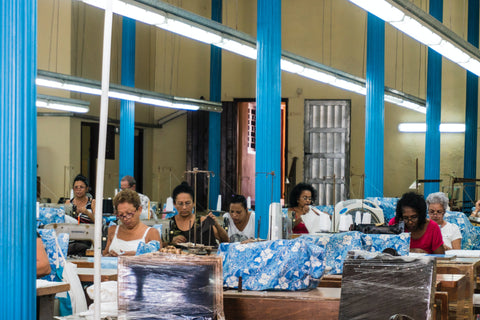
Welcome to Part 2 of Apparel Manufacturing 101. We finished Part 1 with final samples. Final samples complete the process of pre-production and then the production phase begins with grading.
7. Grading
Grading is essentially sizing up or down from your sample size and creating a pattern for each size in your run. While the concept of grading is simple, it takes a lot of knowledge and skill to do it right. Think about it. When a person gains weight, every part of their body doesn’t get proportionately bigger. Generally, your butt is going to get bigger and your boobs are going to get bigger, but your forearms aren’t going to grow at the same rate. And, unfortunately for many of us, your legs aren’t going to get any longer!
Because Dessous’s caftans are meant to fit oversized, our size run is limited. A grader gets paid according to how many sizes you’re making. For patterns that are more fitted like jeans, or for a brand that has a very wide size range, grading can get quite expensive.
8. Marking
Marking is a step in the process that I never thought about before starting Dessous. Marking is laying out pattern pieces, either manually or using marking software, to leave the least possible amount of waste fabric after cutting. The marker has to be aware of the grainline of the fabric and ensure that prints and stripes will be facing the right direction when the garment is sewn.
Marking is particularly important for brands that value sustainability. At Dessous, we donate all our waste fabric, but at many large factories, those scraps go directly into a landfill.
9. Laying
Unless you’re making bespoke clothing, you’ll want to be able to lay out as many layers of fabric as possible in order to reduce the amount of cutting you need to do. Similar fabrics can be stacked, but you can’t stack say cotton and silk fabrics without ending up with a slippery nightmare when the cutter tries to cut. Laying also gives an opportunity to inspect the fabric for defects, control the tension of each ply of fabric in the stack and allows fabric to relax before cutting.
10. Cutting
Cutting many layers of fabric is done with a vertical fabric knife much like a jigsaw. To me, cutting is the scariest job in apparel manufacturing. Can you imagine having a 100-ply stack of silk fabric and making a mistake? That would be an extremely expensive mistake.
Cutting is another step in the manufacturing process that is more costly for sustainable fashion companies. Cutting is priced per cut and sustainable companies generally make fewer garments at a time in an effort to reduce inventory and waste. That leads to more cutting and more cost.
11. Sewing
This is the exciting part! In a clothing factory, sewing is done assembly-line style. There are specialized machines for sewing straight lines, sewing curves, creating buttonholes, sewing certain seams, doing decorative stitching and embroidery, sewing in zippers, sewing denim, etc., etc. These aren’t your one-size-fits-all home sewing machines! One facet of sewing I’m still trying to master is learning all the different seams and when it’s best to use each one. The seams you designate for designs can also add time and complexity to a sewing project and increase the overall cost.
In order to get an estimate for per-unit sewing costs, the factory does what’s called a time study. In a time study, factory sewers literally use a stopwatch to time how long it takes to sew a certain garment. So, regardless of how many iterations of your pattern your samplemaker has gone through and how many samples they’ve made, the factory still has to sew their own sample of each garment for costing purposes.
12. Quality Control
Quality Control is a much more detailed process than just casually checking seams and zippers. Garment inspectors do, of course, look for defects, but they also measure garments to make sure they fall within size tolerances set by the designer. They do stretch tests, pull tests and fatigue tests to make sure a garment will stand up to continued wearing and they test stitches per inch, fabric composition and fabric grams per square meter tests to make sure all these meet the previously agreed upon specs. Additionally, someone else on the team clips wayward threads and steams each garment before they’re packed up and shipped to the designer.
That’s it! If you think this sounds like a long and arduous process, you’re absolutely right! Keep in mind that pre-production has to be completed for each new design. Hopefully, now you understand why Dessous launched with just two, fairly simple, styles. I have plans for short caftans, more fitted caftans, tunics and pants in the future. I’m taking it one step at a time, though!
What do you think? Did any of these steps (or just the sheer number of steps) surprise you? Let me know if you have any questions. If I don’t have the answer, I’ll do some research and find out!
